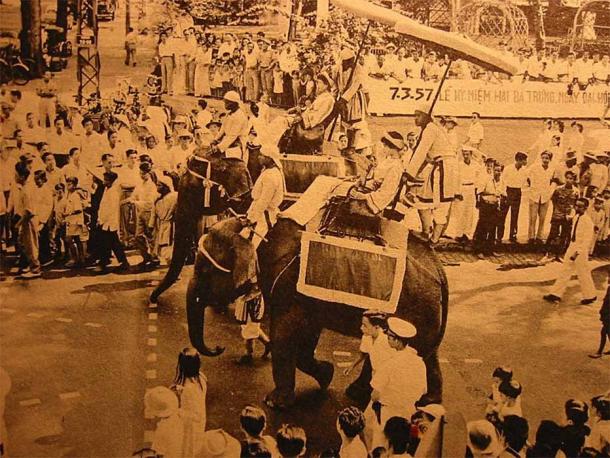
The Trung Sisters – Venerated First-Century Freedom Fighters Of Vietnam
Trần Lệ Xuân, or Madame Ngo Dinh Nhu, the First Lady of the Republic of Vietnam from 1955 to 1963, once celebrated the holiday to commemorate the Trung sisters by riding an elephant in honour of their service and sacrifice. To this day, the Trung sisters are revered as freedom fighter heroes in Vietnam in their struggle for their country’s independence. Several statues and temples such as Hai Bà Trưng Temple near Hoàn Kim Lake in Hanoi, temples in Vietnam's Mê Linh District (Vĩnh Phúc Province), Phúc Thọ District (Hà Tây Province), and Hoàng Hoa Thám Street at the Bình Thạnh District in Ho Chi Minh City are dedicated to them. During his 2017-APEC visit to Vietnam, American President Donald Trump highlighted the Trung sisters' narrative in his speech praising Vietnamese heroism and freedom.

1957 Procession of Elephants in the Hai Ba Trung Parade in Saigon (Public Domain)
Despite their ultimate defeat around 43 AD, the Trung sisters became symbols of resistance and independence in Vietnam for the next 2,000 years. Oral traditions and legends reported by historians like the 13th-century Le Van Huu (1230 – 1322), a historian of the Trần Dynasty, transformed the recollections of women warriors such as the Trung sisters and Ba Trieu, a third-century Vietnamese woman who managed for a time to resist the rule of the Chinese Eastern Wu Dynasty, as well as many others into historical forces in their own right. As a result, the Trung sisters are memorialised in the temple built by Emperor Ly Anh Tong (1136 – 1175 AD) in 1142, following the Chinese practice of establishing temples devoted to heroes and genii. The temple was originally built on the banks of the Red River, a 1,149-kilometer-long (714 miles) river that flows from Yunnan in Southwest China through northern Vietnam to the Gulf of Tonkin.
There are various urban legends regarding the site of the temple. According to a popular legend, after disappearing in the Hac River, the two sisters transformed into stone sculptures. Protecting Vietnam’s independence even after death, the stones walked downstream to the Dong Nhan River and scared off enemy vessels. According to similar myths, the sisters had tremendous magical talents, most notably the capacity to end the drought. According to another legend, Emperor Ly Anh Tong transported the sculptures to Hanoi and established a temple in the sisters’ honour north of the city when his prayers for rain were answered.
Like this Preview and want to read on? You can! JOIN US THERE ( with easy, instant access ) and see what you’re missing!! All Premium articles are available in full, with immediate access.
For the price of a cup of coffee, you get this and all the other great benefits at Ancient Origins Premium. And - each time you support AO Premium, you support independent thought and writing.
Martini Fisher is a Historian and author of many books, including "Time Maps: Matriarchy and the Goddess Culture” | Check out MartiniFisher.com
Top Image: Trung sisters riding elephants. Đông Hồ painting. (Public Domain)
By: Martini Fisher















